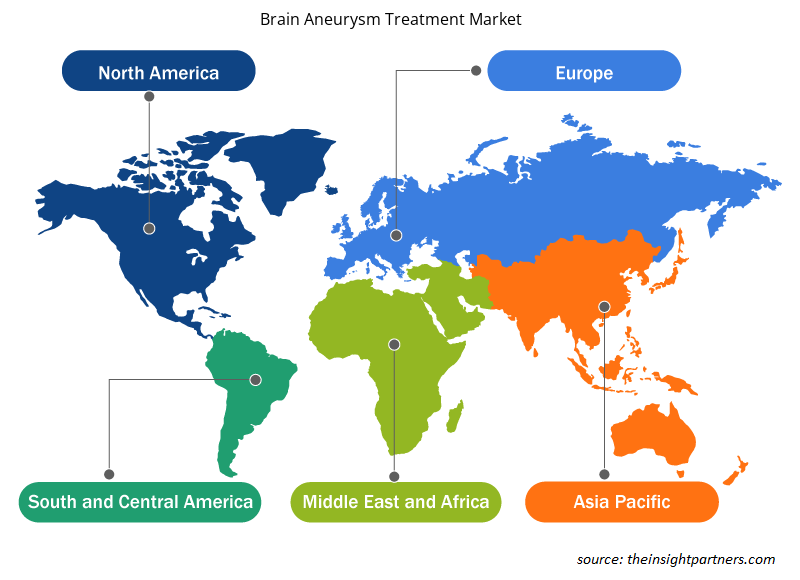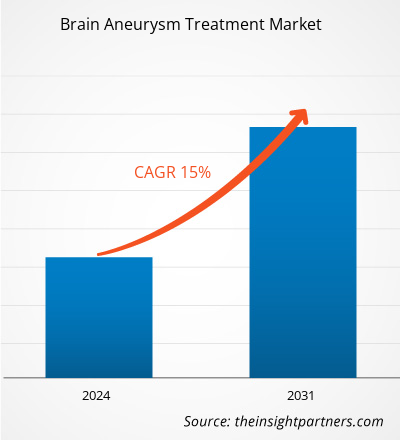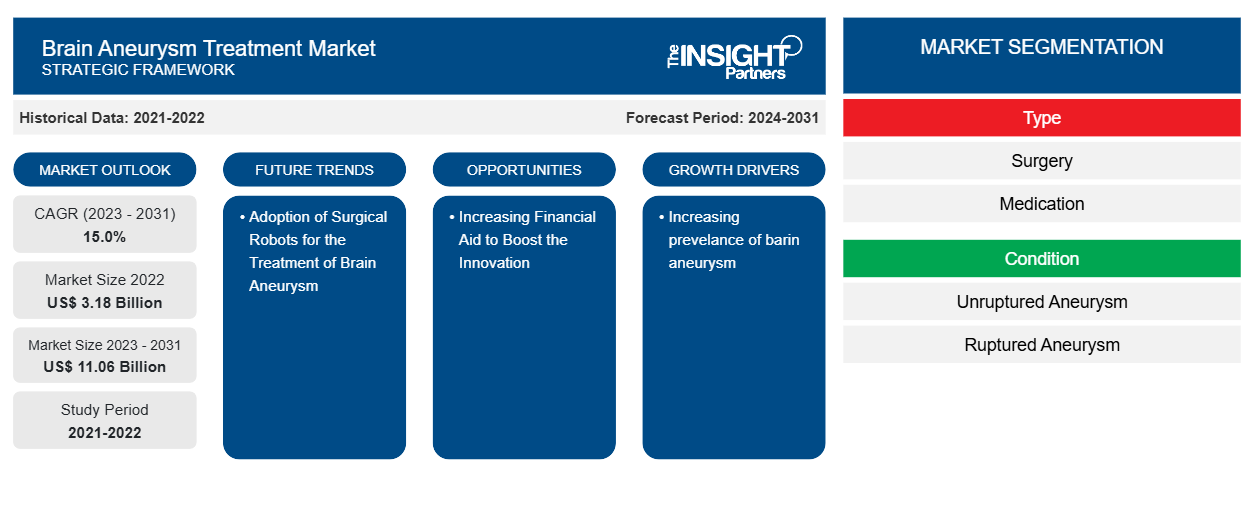Se proyecta que el tamaño del mercado de tratamiento de aneurismas cerebrales alcance los 11.060 millones de dólares estadounidenses en 2031, frente a los 3.180 millones de dólares estadounidenses en 2022. Se espera que el mercado registre una CAGR del 15,0 % entre 2023 y 2031. Es probable que la adopción de robots quirúrgicos para procedimientos de tratamiento de aneurismas cerebrales siga siendo una tendencia clave en el mercado de tratamiento de aneurismas cerebrales.CAGR of 15.0% in 2023–2031. The adoption of surgical robots for brain aneurysm treatment procedures is likely to remain a key Brain Aneurysm Treatment Market trend.
Análisis del mercado de tratamiento de aneurismas cerebrales
Varias organizaciones de investigación y empresas están implementando estrategias constructivas para impulsar los programas de investigación y desarrollo para el tratamiento de los aneurismas cerebrales. En julio de 2022, investigadores de Halifax crearon el endoscopio de ultrasonido de ultraalta resolución para cirugías. Este endoscopio funciona insertando una sonda para visualizar todas las arterias. Además, el producto permitirá a los cirujanos colocar clips en los aneurismas y encontrar todas esas ramas arteriales con mayor confianza. Además, el desarrollo de clips de plástico permite realizar controles posquirúrgicos mediante resonancia magnética (IRM) y tomografías computarizadas (TC), lo que es imposible cuando se utilizan clips metálicos. La tecnología se desarrolló con la ayuda del programa Eureka Eurostars de la Unión Europea, que financió US$ 1,23 millones para I+D. Varias empresas de este espacio también se centran en esfuerzos de colaboración para introducir nuevas tecnologías y productos novedosos para el tratamiento de los aneurismas cerebrales.Eurostars program, which funded US$ 1.23 million for R&D. Several companies in this space also focus on collaborative efforts to introduce new technologies and novel products for treating brain aneurysms.
Descripción general del mercado de tratamiento de aneurismas cerebrales
Se espera que el mercado experimente una tasa de crecimiento significativa debido a varios factores, como la creciente prevalencia de aneurismas cerebrales, el avance tecnológico, el desarrollo y lanzamiento de nuevos productos y la creciente concienciación. Hay varios actores del mercado que han desarrollado clips para aneurismas compatibles con resonancias magnéticas con plástico de grado médico que simplifica los controles posteriores al procedimiento. La creciente prevalencia de la hipertensión, el envejecimiento de la población y el tabaquismo son factores que contribuyen al aneurisma cerebral. Además, se espera que el aumento de la inversión y las actividades de I+D seguidas del aumento en la adopción de robots quirúrgicos anticipen el crecimiento del mercado durante el período de pronóstico.
Personalice este informe según sus necesidades
Obtendrá personalización en cualquier informe, sin cargo, incluidas partes de este informe o análisis a nivel de país, paquete de datos de Excel, así como también grandes ofertas y descuentos para empresas emergentes y universidades.
-
Obtenga las principales tendencias clave del mercado de este informe.Esta muestra GRATUITA incluirá análisis de datos, desde tendencias del mercado hasta estimaciones y pronósticos.
Factores impulsores y oportunidades del mercado del tratamiento del aneurisma cerebral
La creciente prevalencia de aneurisma cerebral y los factores de riesgo asociados favorecen el mercado
El crecimiento del mercado de tratamiento de aneurismas cerebrales se atribuye principalmente a la creciente prevalencia de aneurismas cerebrales en todo el mundo. Además, también se espera que un número cada vez mayor de procedimientos de diagnóstico asociados con el cerebro acelere implícitamente el crecimiento del mercado durante el período de pronóstico. Según los datos publicados por la Brain Aneurysm Foundation en 2023, se estima que 6,8 millones de personas en los EE. UU. padecen aneurismas cerebrales no rotos, lo que representa alrededor de 1 de cada 50 personas. Además, se estima que cada año se producen 500 000 muertes debido a aneurismas cerebrales en todo el mundo. Además, alrededor del 50,0 % de las roturas son fatales y requieren cuidados y atención intensivos.
Aumentar la ayuda financiera para impulsar la innovación: una oportunidad en el tratamiento del aneurisma cerebral
Como los síntomas del aneurisma cerebral son muy complejos de identificar, se estima que uno de cada cinco pacientes no es consciente de los síntomas de la enfermedad. Este es un factor importante que causa un número significativo de muertes en todo el mundo. Para mejorar el diagnóstico y el tratamiento del aneurisma cerebral, varias autoridades gubernamentales y organizaciones están ofreciendo ayuda financiera y plataformas de investigación para investigadores de todo el mundo. Por ejemplo, en 2021, Oxford Endovascular recaudó 10 millones de dólares para completar el trabajo de desarrollo y los primeros datos en humanos a través de ensayos clínicos. Se prevé que esta creciente ayuda financiera para el tratamiento del aneurisma cerebral impulse el crecimiento del mercado.
Análisis de segmentación del informe de mercado de tratamiento de aneurismas cerebrales
Los segmentos clave que contribuyeron a la derivación del análisis del mercado de tratamiento del aneurisma cerebral son el tipo, la condición y el usuario final.
- Según el tipo, el mercado de tratamiento de aneurismas cerebrales se divide en cirugía y medicación. El segmento de medicación tuvo una mayor participación de mercado en 2023.
- Por condición, el mercado se divide en aneurisma no roto y aneurisma roto. El segmento de aneurisma no roto tuvo la mayor participación del mercado en 2023.
- En términos de usuario final, el mercado se divide en hospitales y clínicas. El segmento de hospitales dominó el mercado en 2023.
Análisis de la cuota de mercado del tratamiento del aneurisma cerebral por geografía
El alcance geográfico del informe del mercado de tratamiento de aneurismas cerebrales se divide principalmente en cinco regiones: América del Norte, Asia Pacífico, Europa, Medio Oriente y África, y América del Sur y Central.
América del Norte ha dominado el mercado de tratamiento de aneurismas cerebrales debido a la creciente incidencia de trastornos neurológicos como accidentes cerebrovasculares, aneurismas cerebrales y otros en todo el país. Además, se espera que el crecimiento del mercado en Canadá aumente debido al creciente apoyo del gobierno para abordar las crecientes preocupaciones sobre las enfermedades cerebrales. Además, se estima que el mercado en México crecerá debido al aumento de las industrias médicas y al aumento de las exportaciones de dispositivos médicos a EE. UU. y otros países. Se prevé que Asia Pacífico crezca con la CAGR más alta en los próximos años.
Perspectivas regionales del mercado de tratamiento del aneurisma cerebral
Los analistas de Insight Partners explicaron en detalle las tendencias y los factores regionales que influyen en el mercado de tratamiento de aneurismas cerebrales durante el período de pronóstico. Esta sección también analiza los segmentos y la geografía del mercado de tratamiento de aneurismas cerebrales en América del Norte, Europa, Asia Pacífico, Oriente Medio y África, y América del Sur y Central.

- Obtenga datos regionales específicos para el mercado de tratamiento de aneurismas cerebrales
Alcance del informe de mercado sobre el tratamiento del aneurisma cerebral
| Atributo del informe | Detalles |
|---|---|
| Tamaño del mercado en 2022 | US$ 3.18 mil millones |
| Tamaño del mercado en 2031 | US$ 11.06 mil millones |
| CAGR global (2023 - 2031) | 15,0% |
| Datos históricos | 2021-2022 |
| Período de pronóstico | 2024-2031 |
| Segmentos cubiertos |
Por tipo
|
| Regiones y países cubiertos |
América del norte
|
| Líderes del mercado y perfiles de empresas clave |
|
Densidad de actores del mercado de tratamiento del aneurisma cerebral: comprensión de su impacto en la dinámica empresarial
El mercado de tratamiento de aneurismas cerebrales está creciendo rápidamente, impulsado por la creciente demanda de los usuarios finales debido a factores como la evolución de las preferencias de los consumidores, los avances tecnológicos y una mayor conciencia de los beneficios del producto. A medida que aumenta la demanda, las empresas amplían sus ofertas, innovan para satisfacer las necesidades de los consumidores y aprovechan las tendencias emergentes, lo que impulsa aún más el crecimiento del mercado.
La densidad de actores del mercado se refiere a la distribución de las empresas o firmas que operan dentro de un mercado o industria en particular. Indica cuántos competidores (actores del mercado) están presentes en un espacio de mercado determinado en relación con su tamaño o valor total de mercado.
Las principales empresas que operan en el mercado del tratamiento del aneurisma cerebral son:
- Corporación Stryker
- Corporación científica Microport
- Corporación Terumo
- Penumbra, INC.
- Medtronic
- Servicios Johnson & Johnson, INC.
Descargo de responsabilidad : Las empresas enumeradas anteriormente no están clasificadas en ningún orden particular.

- Obtenga una descripción general de los principales actores clave del mercado de tratamiento de aneurismas cerebrales
Noticias y desarrollos recientes del mercado de tratamiento de aneurismas cerebrales
El mercado de tratamiento de aneurismas cerebrales se evalúa mediante la recopilación de datos cualitativos y cuantitativos posteriores a la investigación primaria y secundaria, que incluye publicaciones corporativas importantes, datos de asociaciones y bases de datos. A continuación, se incluye una lista de los avances en el mercado de tratamiento de aneurismas cerebrales y las estrategias:
- La empresa recibió la autorización de 510.000 dólares para el espiral desprendible Target Tetra. El espiral desprendible Target Tetra combina una nueva forma tetraédrica y un nivel de suavidad, diseñado específicamente para tratar pequeños aneurismas en diferentes partes del cuerpo, incluido el cerebro. (Fuente: Stryker, comunicado de prensa, 2023)
- La empresa lanzó los nuevos coils desmontables CEREPAK en EE. UU. Los coils desmontables CEREPAK ofrecen tres formas y múltiples tamaños de coils, lo que brinda a los médicos opciones integrales para embolizar aneurismas cerebrales, incluidos coils diseñados específicamente para lograr un llenado concéntrico del aneurisma y contribuir a un gran llenado volumétrico. (Fuente: CERENOVUS, Inc., Boletín informativo, 2023)
- La empresa recibió la aprobación de la FDA de EE. UU. en abril de 2020 para su nueva bobina de embolización de aneurisma cerebral (nombre del producto: i-ED COIL) y la ha comercializado a través de Kaneka Medical America LLC desde septiembre de 2020. Al firmar un acuerdo de alianza de ventas con Asahi Intecc USA. Inc., Kaneka tiene la intención de expandir aún más las ventas en el mercado estadounidense a partir de agosto de 2021. (Fuente: Kaneka Corporation, comunicado de prensa, 2021)
Informe sobre el mercado de tratamiento de aneurismas cerebrales: cobertura y resultados
El informe “Tamaño y pronóstico del mercado de tratamiento de aneurismas cerebrales (2021-2031)” proporciona un análisis detallado del mercado que cubre las siguientes áreas:
- Tamaño del mercado y pronóstico a nivel global, regional y nacional para todos los segmentos clave del mercado cubiertos bajo el alcance
- Dinámica del mercado, como impulsores, restricciones y oportunidades clave
- Principales tendencias futuras
- Análisis detallado de las cinco fuerzas de Porter y PEST y FODA
- Análisis del mercado global y regional que cubre las tendencias clave del mercado, los principales actores, las regulaciones y los desarrollos recientes del mercado.
- Análisis del panorama de la industria y de la competencia que abarca la concentración del mercado, el análisis de mapas de calor, los actores destacados y los desarrollos recientes
- Perfiles detallados de empresas
- Análisis histórico (2 años), año base, pronóstico (7 años) con CAGR
- Análisis PEST y FODA
- Tamaño del mercado, valor/volumen: global, regional y nacional
- Industria y panorama competitivo
- Conjunto de datos de Excel
Informes recientes
Testimonios
Razón para comprar
- Toma de decisiones informada
- Comprensión de la dinámica del mercado
- Análisis competitivo
- Información sobre clientes
- Pronósticos del mercado
- Mitigación de riesgos
- Planificación estratégica
- Justificación de la inversión
- Identificación de mercados emergentes
- Mejora de las estrategias de marketing
- Impulso de la eficiencia operativa
- Alineación con las tendencias regulatorias























 Obtenga una muestra gratuita para - Mercado de tratamiento de aneurismas cerebrales
Obtenga una muestra gratuita para - Mercado de tratamiento de aneurismas cerebrales